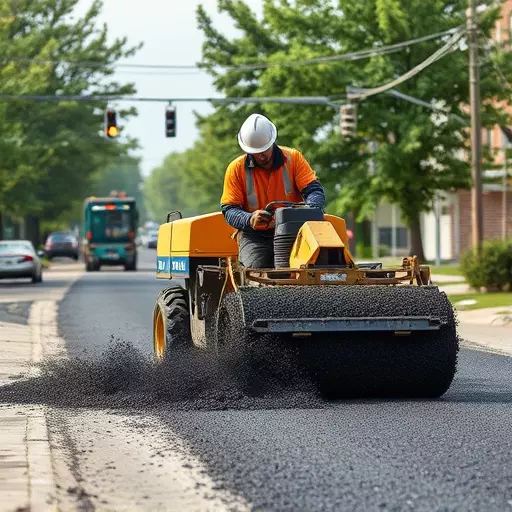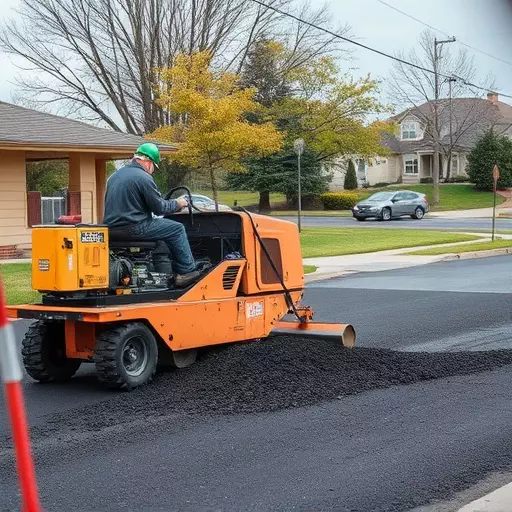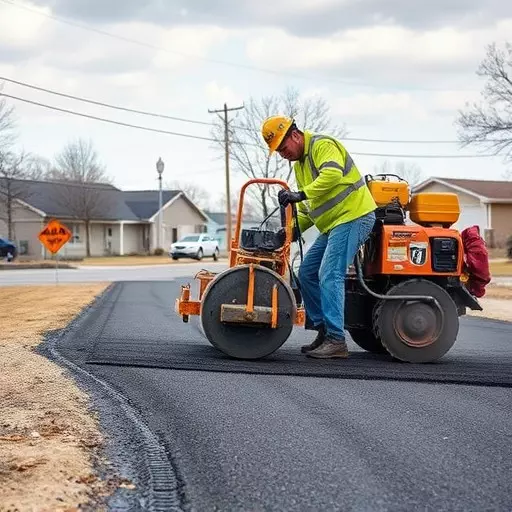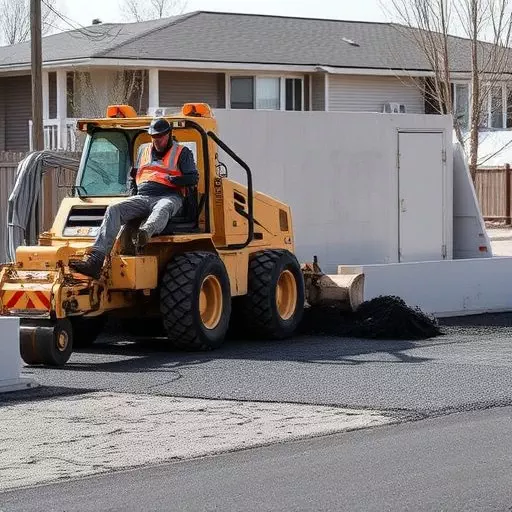Toledo's asphalt demolition contractors utilize pavement milling—a cost-effective, eco-friendly method—to maintain and renovate roads. This process grinds 1-2 inches of asphalt or concrete while capturing material for recycling or reuse. Contractors employ this technique for minor repairs and new paving projects, balancing quality and cost. They use pavement milling for precise depth control, preserving base layers, and offer advice on project scope, budget, texture needs, and time constraints. Safety and environmental considerations are paramount, with contractors prioritizing worker protection and minimizing pollution from either milling or grinding methods.
In the realm of asphalt maintenance, understanding the nuances between pavement milling and grinding is crucial for both professionals and property owners in Toledo. This article serves as a comprehensive guide, delving into the fundamental concepts of pavement milling—a process that strips and grinds the top layer of asphalt. We explore the role of an expert asphalt demolition contractor in Toledo, examining various asphalt removal techniques and their advantages. By weighing factors like project scope, budget, and environmental impact, readers can make informed decisions, ensuring optimal outcomes for their asphalt removal needs.
- Understanding Pavement Milling: A Basic Overview
- The Role of an Asphalt Demolition Contractor in Toledo
- Asphalt Removal Techniques: Grinding vs. Milling
- When to Choose Pavement Milling Over Other Methods
- Advantages and Disadvantages of Each Technique
- Factors Affecting the Selection of Asphalt Milling or Grinding
- Environmental Impact and Safety Considerations
Understanding Pavement Milling: A Basic Overview

Pavement milling, also known as cold planing, is a process that involves the strategic removal of the top layer of asphalt or concrete from roads, parking lots, and other paved surfaces. This technique is employed by an asphalt demolition contractor in Toledo to prepare the substrate for new paving materials or as part of road maintenance and rehabilitation projects. It offers several advantages over traditional asphalt removal methods.
In this method, specialized equipment with rotating cutting drums grinds away the surface layer, typically 1-2 inches deep, while capturing the removed material for offsite disposal or recycling. This approach is more eco-friendly compared to breaking up pavement by hand or using jackhammers, which can be time-consuming and labor-intensive. Pavement milling provides a cost-effective solution for road repairs, offering a smooth transition to new asphalt installation without requiring complete demolition of the existing surface.
The Role of an Asphalt Demolition Contractor in Toledo

An Asphalt Demolition Contractor in Toledo plays a pivotal role in managing and executing efficient pavement maintenance and renovation projects. These specialists are equipped to handle various asphalt removal techniques, including both milling and grinding methods. Pavement milling, for instance, involves the use of specialized equipment to remove the top layer of asphalt while minimizing disruption to the base material. This process is particularly useful for repairing cracks, removing old markings, or preparing surfaces for new coatings.
In Toledo, where road infrastructure is subject to constant wear and tear, an experienced asphalt demolition contractor can ensure that removal techniques are tailored to specific project needs. They possess the knowledge and resources to balance cost-effectiveness with quality results, contributing to the city’s overall pavement management strategy. By employing advanced machinery and adhering to industry best practices, these contractors facilitate smoother transitions between old and new pavement installations, enhancing the longevity and safety of Toledo’s roads.
Asphalt Removal Techniques: Grinding vs. Milling

When it comes to removing asphalt, two common methods used by asphalt demolition contractors in Toledo are grinding and milling. Both techniques serve the purpose of preparing a surface for new pavement, but they differ significantly in terms of process and outcome. Pavement milling involves using a machine with rotating blades to shave off the top layer of asphalt, leaving behind a smooth, even grade suitable for immediate reuse as base material or further processing. This method is popular due to its cost-effectiveness and efficiency, making it a go-to choice for many asphalt removal projects.
On the other hand, grinding involves using specialized equipment that grinds up the asphalt into smaller, fine particles. This process generates heat which can help to break down the material further. Grinding is often employed when the asphalt needs to be recycled or transformed into new products like asphalt rubble or hot mix asphalt. While it may be more intensive than milling, grinding offers benefits such as better aggregate retention and a higher quality recycled material, making it an attractive option for environmentally conscious projects.
When to Choose Pavement Milling Over Other Methods

When deciding between various asphalt removal techniques, pavement milling stands out as a preferred method for several reasons. One of its key advantages is its versatility; it’s suitable for a wide range of projects, from small-scale repairs to complete pavement replacement. An asphalt demolition contractor in Toledo might recommend milling when the goal is not just to remove the existing surface but also to recycle and reuse the material. This eco-friendly approach not only reduces construction waste but also saves on new aggregate costs.
Milling is particularly effective for maintaining road surfaces, as it can correct minor imperfections, raveling, or uneven areas without removing the base layer. For instance, when a driveway or parking lot shows signs of wear and tear, milling can restore its integrity while preserving the existing subbase, making it a cost-efficient solution compared to complete removal and replacement. This makes pavement milling an ideal choice for homeowners and businesses seeking to extend the lifespan of their asphalt surfaces without breaking the bank.
Advantages and Disadvantages of Each Technique

Asphalt Milling vs. Grinding: Advantages and Disadvantages
Asphalt milling and grinding are both effective asphalt removal techniques*, but they cater to different needs. Pavement milling, or asphalt shaving, involves removing the surface layer of asphalt using a cold planer. This method is advantageous for projects requiring precise depth control, as it allows contractors (like those from Toledo) to mill only the top layer while leaving the base intact. It’s ideal for repavement jobs and creating new surfaces from existing ones. However, milling can be noisier and produce more dust compared to grinding.
On the other hand, asphalt grinding is a quieter process that utilizes specialized equipment to shred the asphalt into small, manageable pieces. This technique is preferred when complete removal of the pavement structure is necessary, as it effectively reduces the material into aggregate for reuse or recycling. Grinding is an eco-friendly option, minimizing dust and noise pollution, making it suitable for urban environments. Yet, it may not be cost-effective for smaller projects due to high machinery requirements and the need for further processing of the removed material.
Factors Affecting the Selection of Asphalt Milling or Grinding

When deciding between asphalt milling and grinding for pavement restoration, several factors come into play. The choice between these two asphalt removal techniques depends on various considerations unique to each project. An experienced asphalt demolition contractor in Toledo, such as those specializing in asphalt removal techniques, would advise that the primary influences are the scope of the project, budget, desired surface texture, and time constraints.
For smaller-scale projects or repairs, asphalt milling might be the preferred option due to its cost-effectiveness and ability to preserve the existing base layer. Pavement milling is a process that efficiently removes the top layer of asphalt while leaving the subbase intact, which can then be recycled and reutilized. On the other hand, grinding is typically more suitable for larger-scale renovations or when a complete transformation of the surface is required. This method produces a smoother, finer material, often used as a base for new asphalt overlays or to create a texture for better traction.
Environmental Impact and Safety Considerations

The environmental impact and safety considerations are crucial aspects when comparing asphalt milling vs. grinding. Pavement milling, a process that involves removing the top layer of asphalt, is often seen as a more eco-friendly option. This technique generates less dust and noise pollution compared to asphalt grinding, which can lead to reduced air and noise disturbances in urban areas. Additionally, milled material can be recycled and reused, further minimizing waste and environmental impact.
However, an asphalt demolition contractor Toledo should always prioritize safety measures during both milling and grinding operations. While milling typically produces less hazardous debris, proper protective equipment is still necessary for workers due to the potential presence of embedded contaminants or sharp edges. In contrast, asphalt grinding generates more dust and finer particles, requiring additional precautions such as water suppression systems to prevent respiratory issues and ensure the well-being of both employees and nearby residents.


